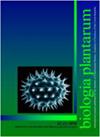氧化石墨烯对水稻幼苗生长的影响及其基因型变异
IF 0.9
4区 生物学
Q4 PLANT SCIENCES
引用次数: 2
摘要
随着石墨烯纳米材料的广泛应用,它们不可避免地进入我们的环境。氧化石墨烯(GO)的潜在植物毒性和环境影响近年来备受关注。我们根据5个水稻基因型(9311、MH63、R527、K866和日本晴)在6种浓度的GO(0、5、10、50、100和150 mg dm-3)下的种子发芽、幼苗形态、生理生化特性和抗氧化酶活性设计了实验。研究了不同浓度GO对发芽指数(GI)、地上部长度(SL)和根长度(RL)、不定根数、地上部和根新鲜质量、根冠比、叶绿素(Chl)含量、丙二醛含量以及超氧化物歧化酶(SOD)、过氧化氢酶(CAT)和过氧化物酶(POD)活性的影响。氧化石墨烯处理显著促进了所有基因型的种子发芽和根系生长,并抑制了地上部生长。此外,我们发现对GO治疗有显著的基因型依赖性反应。从GI、SL和RL、根冠比、抗氧化酶活性(CAT、POD和SOD)和叶绿素含量的相对增加趋势来看,‘R527’对GO处理的耐受性高于其他四个基因型。‘MH63’和‘K866’比‘Nipponbare’和‘9311’更敏感。这表明耐GO基因型可能通过提高抗氧化酶活性来避免GO对自由基的损伤。此外,在评估GO的潜在植物毒性和对生态系统的环境风险时,我们应该考虑基因型差异。本文章由计算机程序翻译,如有差异,请以英文原文为准。
Growth response of Oryza sativa seedlings to graphene oxide and its variability among genotypes
With the extensive utilization of graphene nanomaterials, they inevitably enter our environment. The potential phytotoxicity and environmental impact of graphene oxide (GO) have recently attracted much attention. We designed the experiment based on seed germination, seedling morphology, physio-biochemical properties, and antioxidant enzyme activities of five rice genotypes (9311, MH63, R527, K866, and Nipponbare) under six concentrations of GO (0, 5, 10, 50, 100, and 150 mg dm-3). We studied the effects of different concentrations of GO on germination index (GI), shoot length (SL) and root length (RL), adventitious root number, shoot and root fresh masses, root/shoot ratio, chlorophyll (Chl) content, malondialdehyde content, and activities of superoxide dismutase (SOD), catalase (CAT), and peroxidase (POD). Graphene oxide treatments significantly enhanced seed germination and root growth and inhibited shoot growth of all genotypes. Furthermore, we found a significant genotype-dependent response to GO treatments. According to the relative increment trend of GI, SL, and RL, root/shoot ratio, antioxidant enzyme activities (CAT, POD, and SOD), and Chl content, ‘R527’ showed more tolerance to GO treatments than the other four genotypes. The ‘MH63’ and ‘K866’ were more sensitive than ‘Nipponbare’ and ‘9311’. It indicates that the GO-tolerant genotype might avoid free radicals damage from GO by increased antioxidant enzyme activities. Moreover, we should consider the genotype differences when evaluating the potential phytotoxicity of GO and environmental risk to ecosystems.
求助全文
通过发布文献求助,成功后即可免费获取论文全文。
去求助
来源期刊

Biologia Plantarum
生物-植物科学
CiteScore
2.80
自引率
0.00%
发文量
28
审稿时长
3.3 months
期刊介绍:
BIOLOGIA PLANTARUM is an international journal for experimental botany. It publishes original scientific papers and brief communications, reviews on specialized topics, and book reviews in plant physiology, plant biochemistry and biophysics, physiological anatomy, ecophysiology, genetics, molecular biology, cell biology, evolution, and pathophysiology. All papers should contribute substantially to the current level of plant science and combine originality with a potential general interest. The journal focuses on model and crop plants, as well as on under-investigated species.
 求助内容:
求助内容: 应助结果提醒方式:
应助结果提醒方式:


